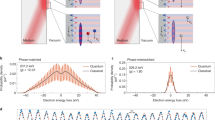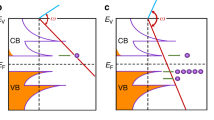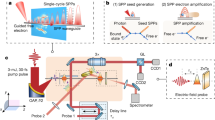Abstract
At the surfaces of nanostructures, enhanced electric fields can drive optical-field photoemission and thereby generate and control electrical currents at frequencies exceeding 100 THz (refs. 1,2,3,4,5,6,7,8,9,10,11). A hallmark of such optical-field photoemission is the sensitivity of the total emitted current to the carrier-envelope phase (CEP)1,2,3,7,11,12,13,14,15,16,17. Here, we examine CEP-sensitive photoemission from plasmonic gold nanoantennas excited with few-cycle optical pulses. At a critical pulse energy, which we call a vanishing point, we observe a pronounced dip in the magnitude of the CEP-sensitive photocurrent accompanied by a sudden shift of π radians in the photocurrent phase. Analysis shows that this vanishing behaviour arises due to competition between sub-optical-cycle electron emission events from neighbouring optical half-cycles and that both the dip and phase shift are highly sensitive to the precise shape of the driving optical waveform at the surface of the emitter. As the mechanisms underlying the dip and phase shift are a general consequence of nonlinear, field-driven photoemission, they may be used to probe sub-optical-cycle emission processes from solid-state emitters, atoms and molecules. Improved understanding of these CEP-sensitive photocurrent features will be critical to the development of optical-field-driven photocathodes for time-domain metrology and microscopy applications demanding attosecond temporal and nanometre spatial resolution.
This is a preview of subscription content, access via your institution
Access options
Access Nature and 54 other Nature Portfolio journals
Get Nature+, our best-value online-access subscription
$29.99 / 30 days
cancel any time
Subscribe to this journal
Receive 12 print issues and online access
$209.00 per year
only $17.42 per issue
Buy this article
- Purchase on Springer Link
- Instant access to full article PDF
Prices may be subject to local taxes which are calculated during checkout



Similar content being viewed by others
Data availability
The data that support the plots within this paper and other findings of this study are included in this article and its Supplementary Information and are available from the corresponding authors upon reasonable request.
References
Putnam, W. P., Hobbs, R. G., Keathley, P. D., Berggren, K. K. & Kärtner, F. X. Optical-field-controlled photoemission from plasmonic nanoparticles. Nat. Phys. 13, 335–339 (2017).
Rybka, T. et al. Sub-cycle optical phase control of nanotunnelling in the single-electron regime. Nat. Photon. 10, 667–670 (2016).
Kruger, M., Schenk, M. & Hommelhoff, P. Attosecond control of electrons emitted from a nanoscale metal tip. Nature 475, 78–81 (2011).
Herink, G., Solli, D. R., Gulde, M. & Ropers, C. Field-driven photoemission from nanostructures quenches the quiver motion. Nature 483, 190–193 (2012).
Schenk, M., Krüger, M. & Hommelhoff, P. Strong-field above-threshold photoemission from sharp metal tips. Phys. Rev. Lett. 105, 257601 (2010).
Paasch-Colberg, T. et al. Solid-state light-phase detector. Nat. Photon. 8, 214–218 (2014).
Ahn, B. et al. Attosecond-controlled photoemission from metal nanowire tips in the few-electron regime. APL Photon. 2, 036104 (2017).
Swanwick, M. E. et al. Nanostructured ultrafast silicon-tip optical field-emitter arrays. Nano Lett. 14, 5035–5043 (2014).
Dombi, P. et al. Ultrafast strong-field photoemission from plasmonic nanoparticles. Nano Lett. 13, 674–678 (2013).
Rácz, P. et al. Measurement of nanoplasmonic field enhancement with ultrafast photoemission. Nano Lett. 17, 1181–1186 (2017).
Piglosiewicz, B. et al. Carrier-envelope phase effects on the strong-field photoemission of electrons from metallic nanostructures. Nat. Photon. 8, 37–42 (2014).
Paulus, G. G. et al. Absolute-phase phenomena in photoionization with few-cycle laser pulses. Nature 414, 182–184 (2001).
Kling, M. F. et al. Imaging of carrier-envelope phase effects in above-threshold ionization with intense few-cycle laser fields. New J. Phys. 10, 025024 (2008).
Apolonski, A. et al. Observation of light-phase-sensitive photoemission from a metal. Phys. Rev. Lett. 92, 073902 (2004).
Dombi, P. et al. Direct measurement and analysis of the carrier-envelope phase in light pulses approaching the single-cycle regime. New J. Phys. 6, 39 (2004).
Rathje, T. et al. Review of attosecond resolved measurement and control via carrier-envelope phase tagging with above-threshold ionization. J. Phys. B 45, 074003 (2012).
Peng, L.-Y., Pronin, E. A. & Starace, A. F. Attosecond pulse carrier-envelope phase effects on ionized electron momentum and energy distributions: roles of frequency, intensity and an additional IR pulse. New J. Phys. 10, 025030 (2008).
Hobbs, R. G. et al. Mapping photoemission and hot-electron emission from plasmonic nanoantennas. Nano Lett. 17, 6069–6076 (2017).
Yalunin, S. V., Gulde, M. & Ropers, C. Strong-field photoemission from surfaces: theoretical approaches. Phys. Rev. B 84, 195426 (2011).
Bormann, R., Gulde, M., Weismann, A., Yalunin, S. V. & Ropers, C. Tip-enhanced strong-field photoemission. Phys. Rev. Lett. 105, 147601 (2010).
Kusa, F., Echternkamp, K. E., Herink, G., Ropers, C. & Ashihara, S. Optical field emission from resonant gold nanorods driven by femtosecond mid-infrared pulses. AIP Adv. 5, 077138 (2015).
Putnam, W. P. et al. Few-cycle, carrier-envelope-phase-stable laser pulses from a compact supercontinuum source. J. Opt. Soc. Am. B 36, A93–A97 (2019).
Keldysh, L. V. Ionization in the field of a strong electromagnetic wave. Sov. Phys. JETP 20, 1307–1314 (1965).
Hentschel, M., Utikal, T., Glessen, H. & Lippitz, M. Quantitative modeling of the third harmonic emission spectrum of plasmonic nanoantennas. Nano Lett. 12, 3778–3782 (2012).
Metzger, B., Hentschel, M., Lippitz, M. & Giessen, H. Third-harmonic spectroscopy and modeling of the nonlinear response of plasmonic nanoantennas. Opt. Lett. 37, 4741–4743 (2012).
Birge, J. R., Ell, R. & Kärtner, F. X. Two-dimensional spectral shearing interferometry for few-cycle pulse characterization. Opt. Lett. 31, 2063–2065 (2006).
Hoff, D. et al. Tracing the phase of focused broadband laser pulses. Nat. Phys. 13, 947–951 (2017).
Acknowledgements
We thank J. Daley for assistance with device fabrication. This work was supported by the US Air Force Office of Scientific Research (AFOSR) through grants FA9550-12-1-0499 and FA9550-19-1-0065, the Center for Free-Electron Laser Science at DESY, the European Research Council under the European Union’s Seventh Framework Programme (FP7/2007-2013) through the Synergy Grant ‘Frontiers in Attosecond X-ray Science: Imaging and Spectroscopy’ (AXSIS) (609920) and The Hamburg Center for Ultrafast Imaging: Structure, Dynamics and Control of Matter at the Atomic Scale, an excellence cluster of the Deutsche Forschungsgemeinschaft. R.G.H. acknowledges support for the device fabrication work from the Center for Excitonics, an Energy Frontier Research Center funded by the US Department of Energy, Office of Science, Office of Basic Energy Sciences under award DE-SC0001088, and support provided by the Royal Society–Science Foundation Ireland University Research Fellowship.
Author information
Authors and Affiliations
Contributions
P.D.K. and W.P.P. conceived the experiment. W.P.P., R.G.H. and Y.Y. fabricated the devices. P.D.K., W.P.P. and P.V. performed the measurements, collected the experimental data and performed the numerical analysis. P.D.K., W.P.P. and P.V. composed the manuscript. P.D.K., W.P.P., P.V., R.G.H., Y.Y., K.K.B. and F.X.K. interpreted the results and contributed to the final manuscript.
Corresponding authors
Ethics declarations
Competing interests
The authors declare no competing interests.
Additional information
Peer review information: Nature Physics thanks Matthias Kling, Christoph Lienau, Johannes Schötz and the other, anonymous, reviewer(s) for their contribution to the peer review of this work
Publisher’s note: Springer Nature remains neutral with regard to jurisdictional claims in published maps and institutional affiliations.
Supplementary information
Supplementary Information
Supplementary Figs. 1–9, Table 1, refs. 1–12 and additional discussion (Sections I–IX).
Rights and permissions
About this article
Cite this article
Keathley, P.D., Putnam, W.P., Vasireddy, P. et al. Vanishing carrier-envelope-phase-sensitive response in optical-field photoemission from plasmonic nanoantennas. Nat. Phys. 15, 1128–1133 (2019). https://doi.org/10.1038/s41567-019-0613-6
Received:
Accepted:
Published:
Issue Date:
DOI: https://doi.org/10.1038/s41567-019-0613-6
This article is cited by
-
Unconventional light - matter interaction in the response-time region of unionized bound electrons
Applied Physics B (2024)
-
Tracing attosecond electron emission from a nanometric metal tip
Nature (2023)
-
An infrared photothermoelectric detector enabled by MXene and PEDOT:PSS composite for noncontact fingertip tracking
Microsystems & Nanoengineering (2023)
-
The emergence of macroscopic currents in photoconductive sampling of optical fields
Nature Communications (2022)
-
On-chip sampling of optical fields with attosecond resolution
Nature Photonics (2021)



